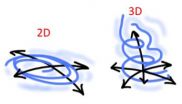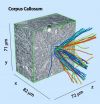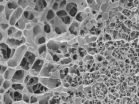(Press-News.org) For seven years, Carsten René Jørgensen from the Department of Psychology and Behavioural Sciences at Aarhus University has collaborated with the Clinic for Personality Disorders, Aarhus University Hospital, Risskov on examining the extent to which modern psychoanalytic psychotherapy can help the Danes suffering from severe borderline personality disorders.
Among the first to examine these forms of modern psychoanalytic treatment of severe personality disorders, the study shows a clear trend; a vast majority of patients do better after a two-year course of treatment.
- It is a patient population that has not been accustomed to receiving much treatment because it is a difficult group, and it has therefore been interesting to examine the effect of more intensive treatment, says Carsten René Jørgensen.
The study compares two forms of treatment. Supportive treatment with group therapy every two weeks and more intensive therapy with weekly sessions involving both group therapy and individual psychotherapy. Both forms of treatment are based on modern psychoanalytic principles.
To the researchers' surprise, both treatments proved highly effective. However, a distinctive feature of the intensive treatment was that patients in this group achieved a higher functional level, which probably indicates that they are more likely to gain a foothold in the labour market.
From public support to the labour market
Borderline personality disorders are among the more serious personality disorders where patients have difficulty dealing with interpersonal relationships and they often experience pronounced fluctuations in their emotions and self-perception. Patients may also be self-harming and have a highly increased risk of abuse and suicide attempts, among other things.
That is also the reason why up to 80% of these patients are publicly supported. The research results indicate, however, that the modern psychoanalytic psychotherapy may be part of the solution to get some of the patients closer to the labour market and self-reliance.
- These are people who suffer greatly, but this treatment helps them to feel better, see their strengths and weaknesses more clearly and become better at handling relations. They will better equip them to start, for example, an education or part-time work, explains Carsten René Jørgensen.
From a socioeconomic point of view it may therefore be beneficial to treat this patient group. Carsten René Jørgensen explains that although the treatment itself requires extensive resources, studies have shown that the socioeconomic savings by offering treatment are higher because the cost of emergency room visits, hospitalisations, local initiatives, benefits and other forms of treatment are reduced.
### Facts about the study
The study compared supportive group psychotherapy treatment and a more intensive therapy with both individual and group therapy. The intensive psychotherapy in particular aims at strengthening the patients' ability to understand themselves, their reactions and those of others as well as interpersonal interactions. Both treatments proved highly effective, but the intensive treatment had a greater effect on the patients' functional level, which is very important for their ability to function in society.
The effect of the treatment presumably requires that it is performed by trained and experienced therapists and that it is conducted in a well-organised clinic. The treatment should also be relatively long-term - two years and sometimes longer - to have a decisive effect.
The study started in 2005. 85 patients have started treatment of which 63 persons have completed two years of treatment. The average age of the patient is just under 30. All patients reside in Central Denmark Region, but the study results can easily be applied in other parts of the country.
It is estimated that 10% of the adult Danish population are suffering from personality disorders of which 1-2% meet the criteria for severe borderline personality disorder.
Effective treatment helps Danes with personality disorders
2012-10-23
ELSE PRESS RELEASES FROM THIS DATE:
Improving medical research education across Europe
2012-10-23
Fostering and improving medical research education is crucial to biomedical research and clinical patient treatment, and as such it has been identified as the main challenge in every joint European Science Foundation (ESF) - European Research Medical Councils (EMRC) strategy report. A new policy report entitled "Medical Research Education in Europe" has just been published looking at crucial factors to improve medical research education throughout Europe.
The new science policy briefing report features an overview of medical researchers' training across Europe. It identifies ...
Leading European experts call for more rigorous scientific evidence for healthcare interventions
2012-10-23
Leading clinicians and health researchers from across Europe say much greater emphasis must be placed on the scientific evidence for the effectiveness of treatments and other healthcare interventions to ensure patients receive the best care available. The call is contained in a Science Policy Briefing published by the European Medical Research Councils, which also made ten key recommendations on how to improve the quality of research and healthcare in Europe.
The briefing, 'Implementation of Medical Research in Clinical Practice', says that there must be much greater ...
Biologists record increasing amounts of plastic litter in the Arctic deep sea
2012-10-23
Biologists record increasing amounts of plastic litter in the Arctic deep sea: studies confirm that twice as much marine debris is lying on the seabed today compared to ten years ago
Bremerhaven, 22nd October 2012. The seabed in the Arctic deep sea is increasingly strewn with litter and plastic waste. As reported in the advance online publication of the scientific journal Marine Pollution Bulletin by Dr. Melanie Bergmann, biologist and deep-sea expert at the Alfred Wegener Institute for Polar and Marine Research in the Helmholtz Association. The quantities of waste observed ...
Next-generation vaccines -- eliminating the use of needles
2012-10-23
Lead scientist Professor Simon Cutting, from the School of Biological Sciences at Royal Holloway, has developed the jabs through the use of probiotic spores. He carried out fundamental studies into the biology of the bacterium Bacillus subtilis which attracted the attention of microbiologists due to its ability to form spores that can last millions of years before germinating under the appropriate environmental conditions.
Professor Cutting says: "The mechanisms by which this process occurs have fascinated microbiologists for decades making it one of the most intensively ...
Turbulent flows in 2D can be calculated in new model
2012-10-23
Turbulent flows have challenged researchers for centuries. It is impossible to predict chaotic weather more than a week in advance. Wind resistance on a plane or a car cannot be calculated precisely, since it is determined by atmospheric turbulence. Now, however, researchers from the Niels Bohr Institute have succeeded in developing a statistical model that can replicate the chaotic flows and thereby provide a better understanding of the process. The research results are published in the scientific journal, Physics of Fluids.
"Without knowing the movements in detail, we ...
Quantum computing with recycled particles
2012-10-23
A research team from the University of Bristol's Centre for Quantum Photonics (CQP) have brought the reality of a quantum computer one step closer by experimentally demonstrating a technique for significantly reducing the physical resources required for quantum factoring.
The team have shown how it is possible to recycle the particles inside a quantum computer, so that quantum factoring can be achieved with only one third of the particles originally required. The research is published in the latest issue of Nature Photonics.
Using photons as the particles, the Bristol ...
A circuit diagram of the mouse brain
2012-10-23
This press release is available in German.
What happens in the brain when we see, hear, think and remember? To be able to answer questions like this, neuroscientists need information about how the millions of neurons in the brain are connected to each other. Scientists at the Max Planck Institute for Medical Research in Heidelberg have taken a crucial step towards obtaining a complete circuit diagram of the brain of the mouse, a key model organism for the neurosciences. The research group working with Winfried Denk has developed a method for preparing the whole mouse ...
Lung mucus gel scaffold prevents nanoparticles from getting through
2012-10-23
Mucus coats our airways' internal surfaces. The viscous gel humidifies the lungs and prevents viruses and other small particles like diesel soot from entering the body unchecked. Previously unclear was the extent to which such nanoparticles are able to move through the lungs' mucus. Here, the research evidence was contradictory. Scientists could not explain why, in inhaled medication development, drug nanoparticles often simply got stuck in the mucus never making it to their target destination inside the lung cells.
Now, as part of a German Research Foundation (DFG)-funded ...
The complex association between moderate alcohol consumption and breast cancer
2012-10-23
An excellent review article from two scientists at the National Institute on Alcohol Abuse and Alcoholism in the USA to be published in Alcohol Clin Exp Res 2012, describes the epidemiologic and basic scientific evidence linking alcohol consumption to the risk of breast cancer.
The authors point out deficiencies in the epidemiologic data, especially that the pattern of drinking (regular moderate versus binge drinking) has generally not been taken into consideration, important given that binge drinking is associated with much higher blood alcohol concentrations and acetaldehyde ...
TIM and TAM: 2 paths used by the Dengue virus to penetrate cells
2012-10-23
By demonstrating that it is possible to inhibit the viral infection in vitro by blocking the bonding between the virus and these receptors, the researchers have opened the way to a new antiviral strategy. These works were published on line in the review "Cell Host & Microbe" of October 18, 2012.
The Dengue virus circulates in four different forms (four serotypes). It is transmitted to humans by mosquitoes. It is a major public health problem. Two billion people throughout the world are exposed to the risk of infection and 50 million cases of Dengue fever are recorded by ...


